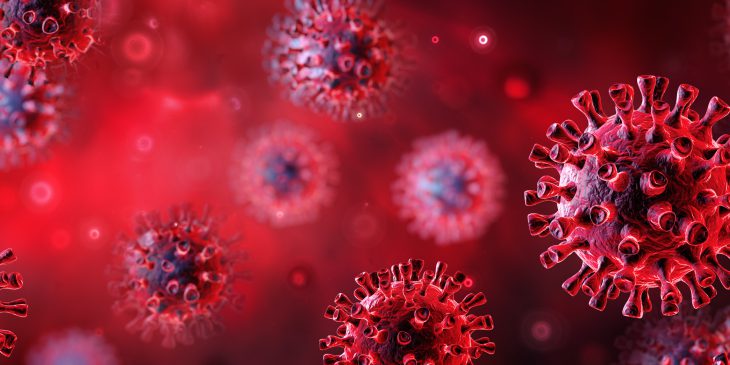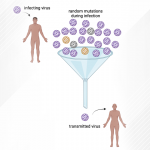The latest variant, or sublineage, of SARS-CoV-2 to emerge on the scene, BA.2.86, has public health experts on alert as COVID-19 hospitalizations begin to rise and the new variant makes its way across the globe.
The Conversation asked Suresh V. Kuchipudi, a virologist and infectious disease expert at the University of Pittsburgh School of Public Health, to explain what researchers know about BA.2.86’s ability to dodge immune protection and whether it causes more severe infection than its predecessors.
- What is BA.2.86 and how is it related to earlier variants?
BA.2.86, nicknamed Pirola, is a highly mutated new omicron sublineage of SARS-CoV-2 that was first detected in Denmark in July 2023. The World Health Organization announced that, as of Sept. 6, 2023, BA.2.86 has been detected in 11 countries.
A variant is an alternate version of a virus – in this case, the SARS-CoV-2 virus that causes COVID-19 – that has some mutations or changes in its genetic code, compared with the original. Mutations can alter the behavior of the viruses in various ways, such as how effectively they break into cells and how rapidly they can replicate.
The WHO names these variants using Greek alphabet letters, like alpha, delta and omicron. However, another naming system called the PANGO, or pangolin – short for phylogenetic assignment of named global outbreak lineages – tracks variants and their offshoots by way of a lineage system.
Think of it as a family tree for the virus, which is grouped into different lineages, like branches on a tree. The omicron variant is like a big family, and its known family members – BA.2, BA.2.86 and XBB.1.5 – are all branches – or lineages and sublineages – on the same tree.
- What is most unique about BA.2.86?
After the omicron variant showed up in November 2021, it didn’t stay the same for long. It kept changing, and soon we got different sublineages of it, such as BA.2, BA.4 and BA.5. The one that’s been dominant globally for most of 2023, called XBB.1.5, originated from the mixing, or recombination, of two separate sublineages.
But what’s interesting is that BA.2.86, the newest sublineage on the scene, seems to have come from the older BA.2 omicron lineage that was dominant in early 2022 and not from the newer omicron offshoots.
A preliminary study reported that BA.2.86 features 33 distinct spike mutations when compared to its precursor, BA.2. The spike proteins, which form the knobby protrusions coming off the main body of the virus, are like a key that the virus uses to unlock our cells, which is how a new infection begins.
After an infection by one of the variants that cause COVID-19, our bodies create antibodies that target the spike protein to help neutralize the virus and prevent it from infecting cells. So, numerous changes in the spike protein of BA.2.86 could potentially affect how well it evades antibodies as well as the degree of disease severity it causes.
Among the new mutations that BA.2.86 carries, 14 reside within an area of the spike protein called the receptor binding domain, which binds to the receptors on host cells. This suggests that BA.2.86 could have a greater capacity for infecting than its predecessor.
In addition, the new sublineage, BA.2.86, is even more dissimilar when compared to the most recent sublineage, XBB.1.5, with 35 new mutations in the spike protein – including some unusual mutations – than to its precursor, BA.2. These alterations intrigue infectious disease specialists like me, and we are working to understand how they might affect this new variant’s behavior.

Suresh Kuchipudi, Ph.D., professor and chair of the Department of Infectious Diseases and Microbiology at the University of Pittsburgh School of Public Health, attending the G20 Summit in India.
- How concerning are the new variant’s mutations?
We researchers do not yet fully understand what these changes might mean and the degree to which BA.2.86 can get around our protective defenses.
Scientists and health authorities closely monitor all emerging variants and lineages for changes that can affect how easily the virus is transmitted, what it might mean for vaccine effectiveness and the severity of disease it can cause. While mutations can be cause for concern, it’s important to remember that not all mutations lead to increased danger.
The earlier-mentioned preliminary study found that BA.2.86 can escape the protective defenses of antibodies against the recent XBB sublineages. However, in contrast, another new study that has not yet been published found that neutralizing antibody responses against BA.2.86 were comparable to or slightly higher against the recent XBB sublineages. Hence further studies are needed to understand BA.2.86’s ability to escape antibody protection.
The emergence of BA.2.86 underscores the need for flexibility in current vaccine strategies to ensure continued effectiveness against these new variants. The newly FDA-approved fall 2023 COVID-19 booster shots are formulated to target XBB.1.5, which was dominant in early 2023 when public health officials made the reformulation decisions. The 2022 booster shot was designed to target both the original strain of SARS-CoV-2 as well as the BA.4 and BA.5 omicron lineages.
- What more do researchers hope to learn about it?
We researchers have much more to learn about BA.2.86’s capacity to evade antibody protection from prior infection or vaccination, its transmissibility and its ability to cause severe disease. It is too early to determine whether the late summer rise in hospitalizations is being caused by this new sublineage.
The fact that the new highly mutated SARS-CoV-2 variant traces its origins back to an omicron variant that circulated more than a year ago is a stark reminder of the complex evolutionary pathways that SARS-CoV-2 can undertake as it adapts and changes. It also underscores the critical need for a more comprehensive understanding of the health threats posed by continually emerging SARS-CoV-2 variants.
This is particularly important as there has been a significant reduction in global SARS-CoV-2 genomic surveillance, which tracks the genetic changes over time and identifies new versions. Losing this type of monitoring hampers the process of working to understand the origins of novel SARS-CoV-2 variants. This critical information helps scientists and doctors make better decisions to protect public health.
COVID-19 variants continue to stay one step ahead of our efforts at combating them, so it will become increasingly important that the U.S. step up its genomic surveillance efforts and stay committed to working collaboratively with other countries.
This article is republished from The Conversation under a Creative Commons license. It originally appeared on Sept. 12, 2023.








